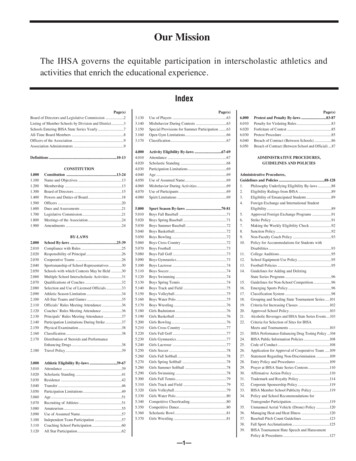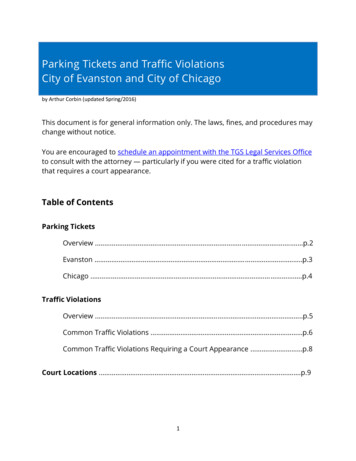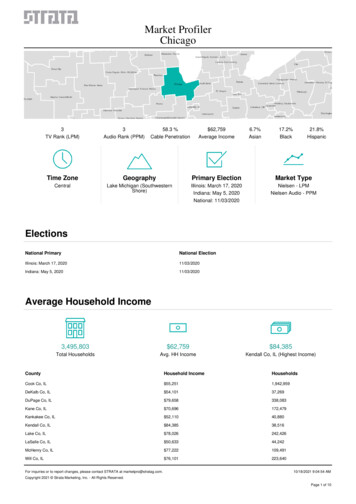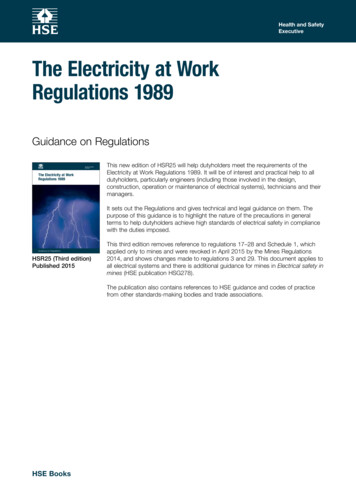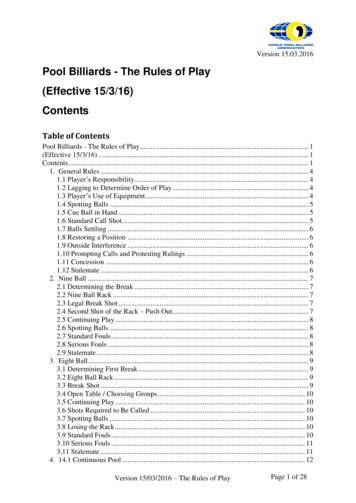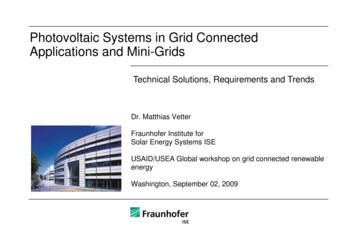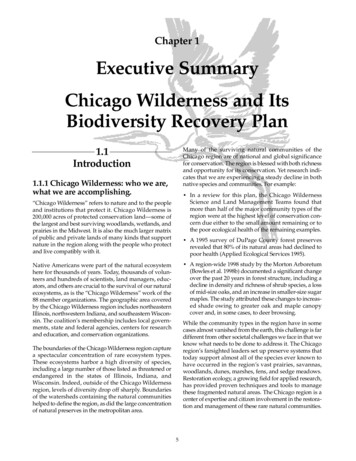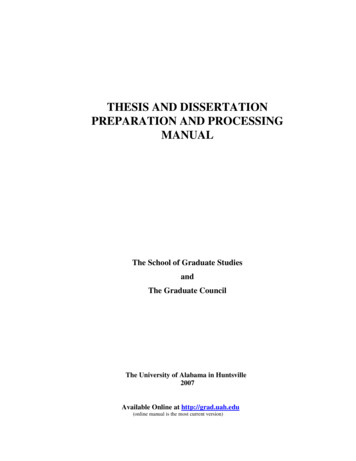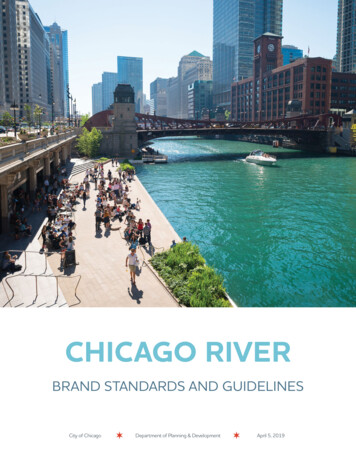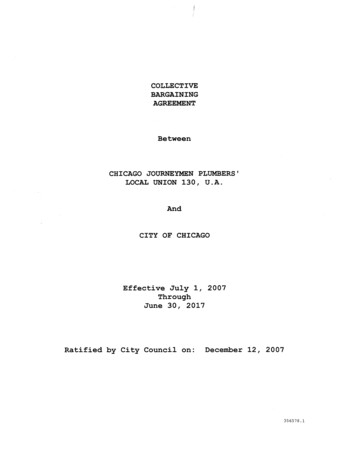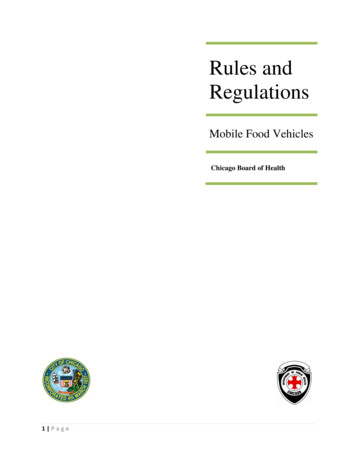
Transcription
Rules andRegulationsMobile Food VehiclesChicago Board of Health1 Page
Chicago Board of Health Rules and Regulations forMobile Food VehiclesBy authority vested in the Chicago Board of Health pursuant to Sections 2-112-100 and 7-38-128of the Municipal Code of Chicago, the following rules and regulations regarding mobile foodvehicles are adopted herein.Rule 1. DefinitionsA. The terms “commissary”, “mobile desserts vendor”, “mobile food dispenser”, “mobile foodpreparer”, “mobile food vehicle”, “mobile food vendor”, and “mobile food truck” shall havethe meanings ascribed to these terms in Section 4-8-010 of the Municipal Code of Chicago.B. The following terms are defined as follows:1. “Chassis-mounted tank” refers to a propane or natural gas tank permanently installed as apart of the body of a mobile food vehicle.2. “HVAC professional” refers to a heating, ventilation and air conditioning professionalwith current license as granted by the Illinois Department of Financial and ProfessionalRegulation.3. “ILCS” refers to the Illinois Compiled Statues as published by the State of Illinois.4. “Natural gas” refers to compressed natural gas used as a fuel source as defined by NFPA52.5. “NFPA” refers to the National Fire Protection Association.6. “NFPA 10” refers to National Fire Protection Association Code 10: Standard forPortable Fire Extinguishers.7. “NFPA 52” refers to National Fire Protection Association Code 52: Vehicular GaseousFuel Systems Code.8. “NFPA 58” refers to National Fire Protection Association Code 58: Liquefied PetroleumGas Code.9. “NFPA 70” refers to National Fire Protection Association Code 70: National ElectricalCode.10. “NFPA 96” refers to National Fire Protection Association Code 96: Standard forVentilation Control and Fire Protection of Commercial Cooking.2 Page
11. “NFPA 1192” refers to National Fire Protection Association Code 1192: Standard onRecreational Vehicles.12. “OSHA” refers to the U.S. Occupational Health and Safety Administration.13. “Propane” refers to liquefied petroleum gas.14. “Second-stage manufacturer” refers to a person or business that modifies a vehicle afterfinal manufacturer construction—common terms for a second-stage manufacturerinclude, but are not limited to “customizer” and “up-fitter.”Rule 2. Application, permitting, inspection and licensure requirementsA. In addition to those requirements set forth in Section 4-8-036 of the Municipal Code ofChicago, applicants for a mobile food vendor license to engage in a mobile food preparer ormobile food dispenser business must submit:1. A blueprint (plan) for the vehicle along with specification sheets on all equipment.2. An inspection report from within the last six months if the commissary is located withinChicago, or from within the last 90 days from the state or local health authority where thecommissary is located, if the commissary is outside of Chicago.3. A blueprint (plan) of the commissary, if the applicant is from outside Chicago.B. In addition to the above requirements, applicants whose vehicles will use an onboardelectrical power inverter will need to submit a signed affidavit attesting to the fact that: (1)the inverter is certified by Underwriters Laboratory (UL); (2) the applicant is aware of themaximum capacity of the inverter and will utilize and maintain it according tomanufacturer’s specifications; and (3) a licensed mechanic installed and mounted the inverteraccording to manufacturer’s specifications.C. In addition to the above requirements, applicants whose vehicle will have a fire suppressionsystem will need to have the company that designed the system submit vehicle plans to theChicago Fire Department (CFD), along with a 150.00 non-refundable fee.D. In addition to the above requirements, applicants whose vehicles will use a generator,propane, compressed natural gas or have a fire suppression system must obtain a fire safetyapproval. Such approval can only be granted after :1) the CFD has reviewed and approvedthe applicant’s fire suppression system; 2) the vehicle has passed a joint inspection by theCFD and the Health Department; and 3) the applicant submits the the following information,along with a 100.00 non-refundable fee, to the CFD:1. Name and address of the applicant, name and address of the business and name andaddress of the commissary.3 Page
2. If the vehicle has propane or natural gas, the names(s) of all employees thatcompleted a CFD-approved propane/natural gas handling training course.3. Detailed diagrams (preferably three-dimensional computer-aided drawings) of thepropane, natural gas and fire suppression system and vehicle layout from no fewerthan four different perspectives, including a top-view layout and an interior cut-awaydrawing of the equipment mounted along each wall.4. Number, size, location and model of propane and natural gas tanks.5. Number, size, location, year of production, make and model of each propane andnatural gas appliance.6. Location and model of all electrical equipment.7. Location, model and size (Amps/Voltage) of in-line generators.8. Location, size, make, model and installer of fire suppression system and exhausthood.9. Location, total cubic feet per minute (cfm) output, make, model and installer ofventilation system.10. Location and type of all flammable liquids and other fire hazards.11. Picture of vehicle tire and loading placard located within driver’s door frame and apicture of certified scale ticket for the vehicle obtained from a weigh station as finallyconfigured.12. Name and registration information of the manufacturer of the vehicle, includingIllinois Dealer’s License number or comparable registration from another state(including the identity and qualifications of any customizers, up-fitters or secondstage manufacturers that have altered the configuration of the vehicle or consulted inthe design process).13. If the permit application involves a previously-owned vehicle, it must include: 1)digital pictures of the propane, natural gas and fire suppression systems; 2) kitchenlayout in present working order from no fewer than three angles; 3) a description ofany modifications made to the vehicle since initial licensure; and 4) the identity ofsecond-stage manufacturers involved.The CFD shall review each complete fire safety approval application to determine whetherthe vehicle meets the fire safety specifications outlined in Rule 4. The Deputy FireCommissioner of the CFD shall have final authority to approve or deny mobile food vehiclefire safety applications and specify any amendments or revisions that may be necessary.4 Page
E. Continuing expectations for fire safety permit holders:1. Once approved, visual design plans must be posted and made visible in the mobile foodvehicle for inspection personnel to examine. In addition, a complete copy of the approvedfire safety permit application must be kept in the vehicle at all times.2. Operators must resubmit a complete fire safety approval application if any proposeddesign or equipment change alters their vehicle’s approved fire safety configuration. Anyreconfiguration, replacement or addition of equipment shall be considered an alteration toa vehicle’s fire safety configuration, except that the replacement of a piece of equipmentwith an identical make, model and configuration of the same or more recent productionshall not be considered an alteration.3. Digital pictures of all flammable materials and propane and natural gas safety systems intheir current working configuration should be submitted with every subsequent licenserenewal to the fire department.4. Fire safety approvals shall expire upon expiration of the mobile food vendor license.Rule 3. Truck and equipment requirementsA. In addition to those requirements set forth in Sections 7-38-075, 7-38-090 and 7-38-120 ofthe Municipal Code of the City of Chicago, the following requirements apply to the vehiclesused to conduct a mobile food dispenser or mobile food preparer business and to theequipment used within the vehicle:1. All mechanical refrigeration and heating equipment must be equipped with athermometer.2. All windows, doors and other openings must be in good repair and be provided withscreens or flaps to prevent the entrance of insects or other pests. Service windows mustbe protected with screens of a size no larger than 16 Mesh to the inch and must be tightfitting and free of breaks. Service windows mustbe closed when not in use. All doorsmust hall be self-closing.3. The food preparation area must be physically separated from the driver’s area with seatsdesignated for the cook and all passengers located outside of the food preparation area.4. The potable water intake valve on the vehicle must be of different dimensions than thevalve used to drain liquid waste from the retention tank, and the intake valve must beprotected from contamination when not in use.5 Page
5. All food storage, preparation and service must be contained within the mobile foodvehicle. No trailers or other ancillary equipment for the storage, preparation or service offoods are allowed to be attached to the mobile food vehicle.6. The three-compartment sink must have a grease trap.Rule 4. Fire safety requirementsA. In addition to the requirements set forth in Rule 3, the following apply to mobile foodvehicles with a generator, propane, compressed natural gas or a fire suppression system:1. To be considered in proper working order, mobile food vehicles must adhere to the belowspecifications and approved fire safety plans, and be supervised by a person possessing aChicago Fire Department (CFD)-approved propane/natural gas handling certification atall times. A fire safety permit application and subsequent inspections must demonstratecompliance with these specifications.2. Propane and natural gas tanks. Only U.S. DOT-approved models of propane and naturalgas tanks (49 CFR 178) may be used on mobile food vehicles. Tanks must be properlylabeled with prominent safety placards in accordance with U.S. DOT regulations (49CFR 178). Tanks must be equipped with a regulator as prescribed by NFPA 58—6.23.4and 5.2.15. No quick-connect devices (as defined in NFPA 58—7.2.2.5) are allowed,except on chassis-mounted tanks. Any such quick connect devices on chassis mountedtanks must be equipped with a manual shutoff.3. Manufacturer specifications. Mobile food vehicle operators must follow manufacturerspecifications and best practices for their vehicle as configured in their fire safety permit,especially with respect to weight distribution of the vehicle.4. Mounting and placement of propane and natural gas tanks. The mounting of propane andnatural gas tanks must withstand impact equal to four times the weight of the filledpropane or natural gas container according to NFPA 58—6.23.3.4. Tanks must be secure(NFPA 58—5.2.4) and conform with NFPA standards relating to the safe mounting oftanks as described in NFPA 58—6.23.3.3. Under these guidelines there are threepermitted mounting options for propane and natural gas tanks:a. Outside mounted in a semi-enclosed cabinet, with vents at the top and bottom tofacilitate the diffusion of vapors, vapor-tight to the interior of the vehicle, with aweather-protected regulator and a leak indicator as described in NFPA 1192—6.4.8.b. Outside mounted, secured on top and bottom and stabilized (e.g. with a strap),vapor-tight to the interior of the vehicle, mounted no less than 28” above theground with a weather-protected regulator.6 Page
c. Chassis mounted, according to NFPA 58—6.23.3.4No gas tanks are permitted to be installed on the roof of the vehicle under anycircumstances. In addition, no flammable liquids are permitted to be stored inside thevehicle. Such liquids can only be stored in their own separate container in a mannerconsistent with propane and natural gas mounting specifications.5. Cooking equipment. All cooking appliances must be listed by Underwriters Laboratoriesor NSF International for mobile applications for the appropriate fuel and be clearlymarked with the appropriate rating sticker. All fat fryers must have a lid over the oil vatthat can be secured in order to prevent the spillage of cooking oil during transit. This lidmust be secured at all times when the vehicle is in motion.6. Propane and natural gas usage. Propane and natural gas tanks must be shut off while themobile food vehicle is in motion, unless the tank is equipped with an impact detectionshutoff device approved by the U.S. DOT. Propane and natural gas tanks must always beshut off while the vehicle is unattended and/or in overnight storage.7. Automatic and manual shutoffs. Each gas-fired appliance must be equipped with anautomatic device designed to shut off the flow of gas to the main burner and pilot in theevent the pilot flame is extinguished (modified from NFPA 58—5.20.7A). The mainsystem shutoff valves located on or closest to the fuel tanks and sufficient to stop thesupply of fuel from all fuel tanks must be clearly marked with the words “PROPANEAND NATURAL GAS SHUTOFF VALVE” permanently affixed to the outside of thevehicle in reflective decal material with letters 2” high at minimum.8. Fire suppression system and extinguishers. All mobile food vehicles must be equippedwith a working R103 or K Class automatic fire suppression system according to NFPA96—10.2.1 and 10.2.2, which is regularly maintained according to NFPA 96—11.2.1 forthe lifetime of the vehicle. All vehicles must also be equipped with no less than one 10BC-rated fire extinguisher, or, if a deep fryer is present in the vehicle, a Class K fireextinguisher. Extinguishers must have current annual inspection tags as outlined byNFPA 10 and Municipal Code of the City of Chicago.9. Kitchen exhaust hood. Each mobile food vehicle that uses propane or natural gas forcooking must be equipped with a Type I or Type II commercial kitchen exhaust hood asdefined by Chapter 18-28, Article 5 of the Mechanical Code of the City of Chicago.Exhaust hoods must be inspected semi-annually by a licensed HVAC professional toensure continuing maintenance and upkeep.7 Page
10. Ventilation system. The truck must be equipped with a working ventilation system thatmeets the requirements of NFPA 96, Chapter 5. This ventilation system must be inoperation at all times when the cooking equipment of the truck is being used. All fansystems in the cooking area of the truck must have a minimum-combined cubic feet perminute rating equal to twice the volume of the interior of the truck as measured in cubicfeet.11. Detection systems. All mobile food vehicles must be equipped with a working carbonmonoxide detector that meets standards set forth in NFPA 1192—6.4.6. All cabinetmounted tanks must be equipped with a leak indicator according to NFPA 1192—6.4.8.12. Piping. All propane and natural gas piping must be constructed and installed inaccordance with NFPA 58—6.23.5. All propane and natural gas pipes and fixtures mustbe made of steel, copper or brass; no plastic piping for such purposes is permitted. .13. Electrical appliances and generators. All electrical equipment and appliances must beinstalled in accordance with NFPA 70. Only “in-line” electrical generators that arepowered by a hard-lined, manufacturer-installed fuel line taken directly from thevehicle’s main fuel tank may be used. All other types of generators, including, but notlimited to portable stand-alone and separate-fill generators may not be used.14. Certificate of safety. All mobile food vehicles with a GWR of 8,000 pounds or greatermust obtain and keep current a Certificate of Safety as issued by the Illinois Departmentof Transportation in accordance with state law (625 ILCS 5).15. List of required warning labels, placards and tags. The following placards and tags, someof which have been mentioned elsewhere in these specifications, must be prominent andvisible on the interior or exterior of the mobile food vehicle as appropriate. All signs mustconform to U.S. DOT guidelines as outlined in the North American Emergency ResponseGuide or successor publication, or specific organizational requirements outlined here.a. OSHA-approved propane or natural gas 3-in-1 hazard sign placed on the outside ofthe vehicle as close to the tank as possible, which should include no-smokingwarnings in both English and Spanish.b. Shutoff valve markers as outlined in subpart 7 of this section.c. Current annual inspection date tags on fire extinguishers.d. UL or NSF International certification sticker for mobile applications and proper fuelsource on every cooking appliance.8 Page
Rule 5. Propane and natural gas handling requirementsA. In addition to the requirements set forth in Rule 3, the following apply to vehicles usingpropane or natural gas:1. No mobile food vehicle may carry more than 40 pounds of total propane. This standardwill be judged by the rated capacity of propane tanks, and vehicles may carry either one40 pound tank or two 20 pound tanks. The same regulations apply for natural gas tanks.2. Propane and natural gas cylinder refilling or exchange must be performed in accordancewith NFPA 58, Chapter 7, by personnel who have been trained in accordance withSection 4.4. Cylinder exchange may be performed by only 1) a licensed propane andnatural gas company operator or 2) mobile food vendor who has completed a CFDapproved training course. Refilling or exchanging may take place at either a company gasfacility or a commissary. Cylinders must be stored in accordance with Chapter 8 ofNFPA 58. —14.3.3. Mobile food vehicle owners will be held responsible for testing their propane and naturalgas system for leaks with a UL-Classified and Mine Safety and Health Administration(MHSA)-certified combustible gas detector at each instance of refill or exchange. Suchtesting is to be completed and recorded before the vehicle leaves the commissary orfacility premises. After refill or exchange, each propane and natural gas tank must belabeled with a proper handling tag by the operator or vendor, which must include the dateof service and name of individual clearly marked.4. At least one person who has successfully completed the CFD-approved Propane andNatural Gas Handling and Safety Course must be present at all times while the mobilefood vehicle is in operation. This course shall train operators in applicable propane andnatural gas handling best practices as outlined in NFPA 58, Chapter 7. Until permanentcourse certification procedures are established, the Propane and Natural Gas Handlingand Safety Course must be administered by the CFD in consultation with the IllinoisPropane Gas Association and Propane Education & Research Council. Mobile foodvendors must retain certification paperwork in their vehicle at all times.5. Mobile food vehicles must be inspected by propane professionals at least every 90 days.At every inspection, propane professionals must produce a maintenance report. Thisreport must be kept in the vehicle at all times. No mobile food vendor are allowed tooperate their propane or natural gas system longer than 90 days after its last recordedmaintenance by licensed company operators. Vendors are required to seek immediatemaintenance in the event of a leak, fire or other safety incident. The vehicle can not bereturned to service until it has been inspected and certified by a licensed propanecompany operator and a note made in the vehicle’s maintenance record of that incident.9 Page
6. Maintenance records, and records of refilling and exchanging tanks shall be kept by thepropane and natural gas company and mobile food vendor in accordance with NFPA58—14.3.2.4 and 13.3.2.5. An up-to-date copy of all service and maintenance recordsmust be kept in the mobile food vehicle at all times and must be made available to healthor fire inspectors upon request.Rule 6. Commissary requirementsA. Applicants for a mobile food vendor license to engage in a mobile desserts vendor, mobilefood dispenser or mobile food preparer business must operate from a commissary that meetsthe following minimal requirements:1. The commissary must provide a source of potable water other than from a mop sink orother source which has the potential to contaminate the potable water. A hose connectingthe water intake on the vehicle to the valve providing the water source within thecommissary must be NSF 51 food-grade or other approved food grade hose and musthave a backflow protection device. When not in use, the hose must be elevated andotherwise protected from contamination and must not be used for other purpose.2. The commissary must provide a means to dispose of liquid waste. Liquid waste can notbe discharged onto the ground or directly into a storm drain. Instead, the liquid wastemust be drained by gravity directly into a drain or by another means provided it isapproved by the Health Department.3. The valve used to supply potable water and the drain for the waste water dischargemustbe separated by sufficient distance so as to avoid contamination of the potable waterby the waste water.4. The commissary must maintain a log that shall include, at a minimal, the name of themobile food truck licensee, the name of the mobile food truck business (DBA), the dateof service and the time servicing began. Such logs shall be kept by the commissary for aperiod of at least one year following the date of service, and available for review by theHealth Department upon request.B. In addition to the above requirements and those requirements set forth in Section 7-38-138 ofthe Municipal Code of the City of Chicago, the commissary servicing a mobile food vehicleused to support a mobile food preparer business must meet the following requirements:1. The servicing area must have overhead protection. This overhead protection must be apermanent structure affixed to the commissary and of sufficient size to completely coverthe full length, width and height of the truck and the entrance into the commissary.10 P a g e
Alternatively, the servicing area could be a permanent facility that is separate from thecommissary provided it has four walls, a floor and a ceiling. The walls and ceiling mustbe kept clean and in good repair, but need not be smooth, painted or finished in lightcolor or made of non-absorbent materials. This permanent facility must be of sufficientsize to completely accommodate the full length, width and height of the truck.2. All servicing activities, including but not limited to providing potable water, draining thewaste water retention tank, draining the potable water tank, loading and unloading offood and supplies, and cleaning the interior of the truck, must be done under overheadprotection or within the permanent facility.Rule 7. Operational requirementsA. In addition to those requirements set forth in Sections 7-38-115, 7-38-117 and 7-38-124 ofthe Municipal Code of the City of Chicago, the following requirements apply to mobile foodvendor licensees engaged in a mobile food dispenser or mobile food preparer business:1. No potentially hazardous foods are to be kept in the vehicle when the vehicle is instorage. In addition, all equipment and all sources of power must be turned off and alldoors and windows secured so as to prevent unlawful entry.2. No food preparation can occur within the vehicle while the vehicle is in motion.3. All windows and doors and any awnings or other overhangs that may be used to cover theservicing area must be closed and secured while the vehicle is in motion.4. With the exception of a refuse receptacle, no signs, chairs, tables or other accessories areto be placed upon the public way while the vehicle is parked.5. All equipment must be covered and secured properly while the vehicle is in motion.6. The mobile food vehicle must report to the commissary at least once per day for servicingon the days the mobile food vehicle operates.B. In addition to the above requirements and to the requirements set forth in Section 7-38-130 ofthe Municipal Code of the City of Chicago, the following apply to the operations of a mobilefood vehicle used to conduct a mobile food dispenser business:1. Food may undergo a final preparation step by food service personnel provided:a. The final preparation step involves only the addition of non-potentially hazardouscondiments to a previously prepared and packaged menu item.b. This condiment is not cooked, cut, processed or prepared in any way on the vehicle.11 P a g e
c. This condiment is stored at the proper temperature prior to its use.d. The final preparation step is done immediately prior to service to a customer.e. Food service personnel wear gloves or use appropriate utensils during this finalpreparation step. Bare hand contact with the menu item or condiment is not permitted.Rule 8. Global Positioning System (GPS) requirementsA. All mobile food vehicles must be equipped with an operational Global Positioning System(GPS) device. The device must meet the requirements set forth in Section 7-38-115 of theMunicipal Code of the City of Chicago, as well as the following:1. The device must be permanently installed in, or on, the vehicle.2. The device must be an “active”, not “passive” device that sends real-time location data toa GPS service provider; the device is not required to send location data directly to theCity.3. The device must be accurate no less than 95% of the time.4. The device must function while the vehicle is vending food or otherwise open forbusiness to the public, and when the vehicle is being serviced at a commissary as requiredby Section 7-38-138 of the Municipal Code of the City of Chicago or these regulations.The device must function during these times regardless of whether the engine is on or off.5. When the GPS device is required to function, the device will transmit GPS coordinates tothe GPS service provider no less frequently than once every five (5) minutes.B. City personnel will not request location information from a GPS service provider pertainingto a mobile food vehicle unless:1. The information is sought to investigate a complaint of unsanitary or unsafe conditions,practices, or food or other products at the vehicle;2. The information is sought to investigate a food-related threat to public health;3. The information is sought in connection with establishing compliance with Chapter 7-38of the Municipal Code of Chicago or the regulations promulgated thereunder;4. The information is sought for purposes of emergency preparation or response;5. The City has obtained a warrant or other court authorization to obtain the information; or6. The City has received permission from the licensee to obtain the information.C. The GPS service provider must maintain at least six (6) months of historical locationinformation and be able to provide the following:12 P a g e
1. When requested pursuant to Rule 8.B., reports of each transmitted position includingarrival dates, times, addresses, and duration of each stop, in a downloadable format (i.e.PDF, CVS or Excel). If the request is to provide the current location of a vehicle, theGPS service provider must respond immediately with the most recent locationinformation for the vehicle.2. Reports that provide anonymous, aggregate information regarding mobile food vehicleoperations within the City, and do not identify specific mobile food vehicles.3. An application programming interface (API) that is available to the general public.D. If the City establishes a website for displaying the real-time location of mobile food vehicles,for purposes of marketing and promotional efforts, the licensee may choose to provide theappropriate access information to the API of its GPS to enable the posting of the vehicle’slocation on such website. The licensee is not required to provide such information orotherwise allow the City to display the vehicle’s location.E. The following will serve as evidence that the GPS requirements have been met:1. Proof of GPS installation.2. Proof from a GPS tracking device service provider the operator is in compliance with therequirements as stated in this Rule.Adopted on July 16, 2014; published on July 28, 2014; and shall become effective on August 7,2014.Carolyn Lopez, M.D.PresidentChicago Board of Health13 P a g e
4. Mounting and placement of propane and natural gas tanks. The mounting of propane and natural gas tanks must withstand impact equal to four times the weight of the filled propane or natural gas container according to NFPA 58—6.23.3.4. Tanks must be secure (NFPA 58—5.2.4) and conform with NFPA standards relating to the safe mounting of
